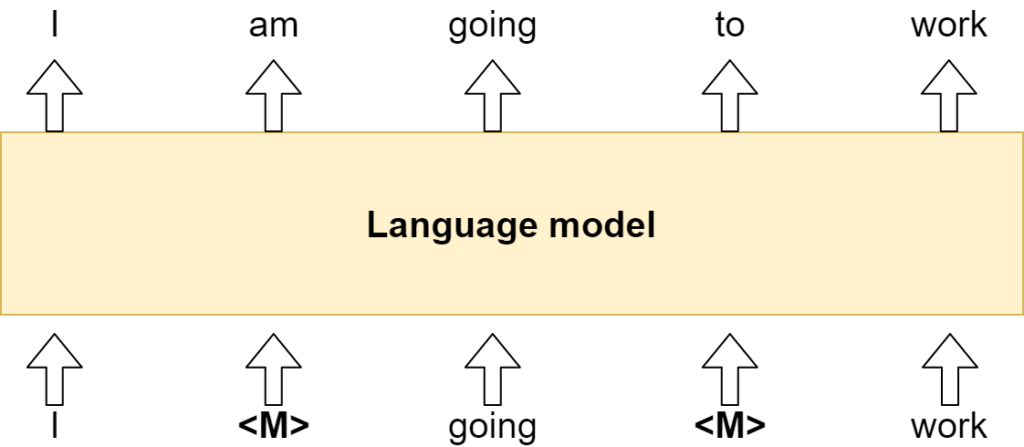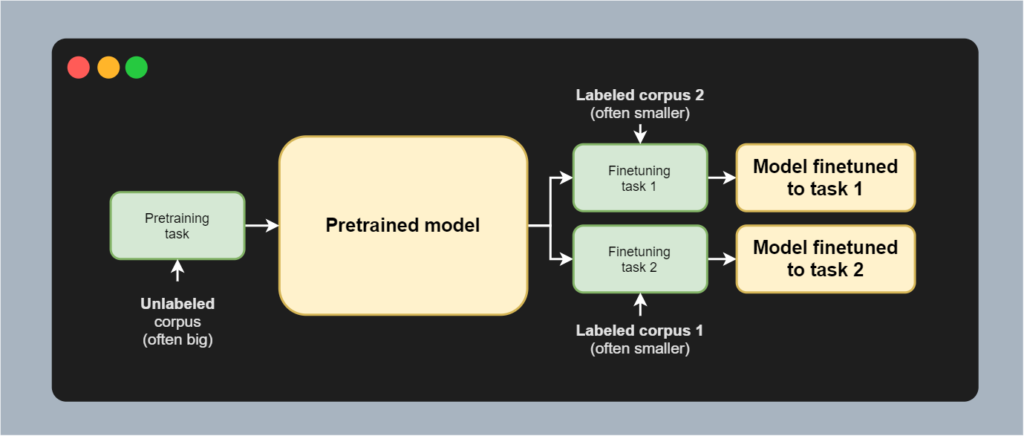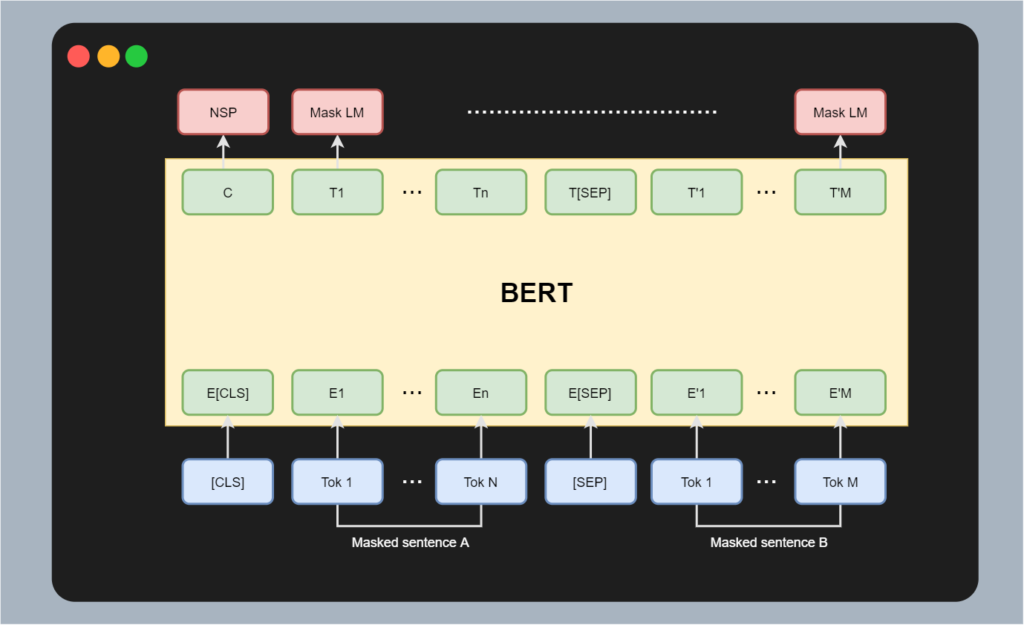Easy Masked Language Modeling with Machine Learning and HuggingFace Transformers
March 2, 2021 by Chris
Masked Language Modeling (MLM) is a language task very common in Transformer architectures today. It involves masking part of the input, then learning a model to predict the missing tokens - essentially reconstructing the non-masked input. MLM is often used within pretraining tasks, to give models the opportunity to learn textual patterns from unlabeled data.
Downstream tasks can benefit from models pretrained on MLM too. Suppose that you are faced with the task of reconstructing the contents of partially destroyed documents. For example, say that you have found a written letter that reads "I am ... to the bakery". While this is easy - going is the expected missing value here - you can imagine that many tasks may benefit if complexity is bigger.
In this tutorial, we will therefore focus on creating a pipeline for Masked Language Modeling. It will be an easy pipeline, meaning that you can do so with only a few lines of code, using a model pretrained before. For this, we will be using the HuggingFace Transformers library.
After reading this tutorial, you will understand...
- What Masked Language Modeling involves.
- How Transformers can be used for MLM tasks, and especially the DistilRoBERTa base model.
- What it takes to build a pipeline for Masked Language Modeling yourself, with only a few lines of code.
Let's take a look 🚀
Update 05/Mar/2021: fixed a small mistake regarding the description of Masked Language Modeling tasks.
Example code: MLM with HuggingFace Transformers
This code example shows you how you can implement Masked Language Modeling with HuggingFace Transformers. It provides a full example for constructing a pipeline, masking a phrase and getting the result with the model. It can be used if HuggingFace Transformers (pip install transformers) and a recent version of TensorFlow 2 or PyTorch are installed in your environment.
Of course, make sure to read the rest of this tutorial as well if you want to understand concepts in more detail! 🚀
from transformers import pipeline
# Initialize MLM pipeline
mlm = pipeline('fill-mask')
# Get mask token
mask = mlm.tokenizer.mask_token
# Get result for particular masked phrase
phrase = f'Read the rest of this {mask} to understand things in more detail'
result = mlm(phrase)
# Print result
print(result)
This yields:
[{
'sequence': 'Read the rest of this article to understand things in more detail',
'score': 0.35419148206710815,
'token': 1566,
'token_str': ' article'
}, {
'sequence': 'Read the rest of this post to understand things in more detail',
'score': 0.20478709042072296,
'token': 618,
'token_str': ' post'
}, {
'sequence': 'Read the rest of this guide to understand things in more detail',
'score': 0.07164707034826279,
'token': 4704,
'token_str': ' guide'
}, {
'sequence': 'Read the rest of this essay to understand things in more detail',
'score': 0.06781881302595139,
'token': 14700,
'token_str': ' essay'
}, {
'sequence': 'Read the rest of this blog to understand things in more detail',
'score': 0.04165174812078476,
'token': 5059,
'token_str': ' blog'
}]
What is Masked Language Modeling?
Today, many language models - primarily Transformers models, which we will discuss in more detail below - are trained on a language task. There is a variety of language tasks. Language modeling is one of them. The goal with language modeling is that given a current set of input tokens, a new token is predicted. This token should obviously be the token that corresponds to the actual next token in the input data. This way, language models can learn to recognize patterns in text.
Masked Language Modeling works slightly differently. In this case, a model does not have access to the full input. Rather, it has access to a masked input, where some (often 10-20 percent) of the input tokens is masked. With masked, we simply mean that the token (and sometimes a span of token) is replaced with a <mask> token. The goal, then, becomes reconstructing the original sequence, i.e. to reveal what is hidden under the mask. The task adds complexity on top of a regular language model task, and some works argue that it can help boost performance.

Masked Language Modeling
MLM is primarily used for pretraining a model, after which it can be finetuned to a particular downstream task. As you can see in the image below, no text needs to be labeled by human labelers in order to predict the missing values. I corresponds to I, am to am, going to going, and so on. The only thing is that some of the words are masked, but the underlying word is available during the improvement step. This is greatly beneficial, since labeling data is a costly task and little labeled data is available. Unlabeled data, however, is ubiquitous. This is why models are often pretrained on these large unlabeled corpora. Subsequently, they can be finetuned to a particular task with a labeled dataset - for example, for text summarization. It is effectively a form of transfer learning, and MLM can greatly help here.

Today's model: a DistilRoBERTa base model
These days, NLP models often make use of the so-called Transformer paradigm. With Transformer models, we no longer need recurrent segments to make sequence compatible machine learning models. This was necessary for quite a long time, significantly impacting the performance of models especially with longer sequences of words.
Vaswani et al. showed in a 2017 paper that Attention is all you need - that, by slightly changing the neural network architecture, the attention mechanism was the only necessary thing in order to build language models that can learn by processing all tokens in parallel. Ever since, Transformer models have been at the forefront of NLP developments. These days, there are many, and BERT is one of them.
What is BERT?
BERT, which stands for Bidirectional Encoder Representations from Transformers, is a special type of Transformer model. Using the left part of the Transformer only - i.e., the encoder segment - it is not a fully Seq2Seq model and must use a special task to generate an encoding during pretraining. As you can see in the image below, it utilizes a Masked Language Modeling task for this purpose.
- In BERT, inputs are separated into two segments per sequence: a sentence A and a sentence B.
- There is a separator token separating both sequences.
- In addition, there is a CLS token that represents class level (i.e. global) information.
Sentences A and B are masked. When processed through BERT, the goal is to reconstruct the original input - a typical MLM task. In addition, the CLS input token produces a C output token. This token contains global information (i.e. information about the sequence as a whole) and is primarily relevant during finetuning, e.g. to generate a model that can perform a task for which the whole sequence is required (such as sentiment analysis).

From BERT to RoBERTa to DistilRoBERTa
While BERT is very successful (in fact, BERT powers many of Google's search queries), it has one drawback: BERT is a really big model. With up to 340 million parameters, it cannot be run on slower machines. Edge devices? Forget it.
That's why in recent years, research communities have started focusing on making Transformers more available to the masses. This approach is twofold. First of all, companies like HuggingFace democratize NLP by creating a generic library for using Transformer based models - and allowing researchers to open source their pretrained and finetuned models for usage by the open source community.
While this is great, it does not solve the problem of BERT's size. That's where efficiency approaches come in. Take ConvBERT, which is a more recent example. It utilizes special convolution operations to replace part of the self-attention mechanism in the BERT model, yielding more efficient training and inference without losing much of the performance. In addition, since BERT was an early Transformer directly spawning from the Vaswani model and the first GPT model, authors had less knowledge about how to pretrain and finetune most optimally.
That's where RoBERTa steps in, which stands for Robust BERT pretraining approach. Described in Liu et al. (2019), the work attempts to replicate the training process for BERT - and found that BERT is significantly undertrained. They design and validate a new pretraining approach which allows their version of BERT to significantly outperform the then state-of-the-art.
But RoBERTa is still big. That's why we use a distilled variant called DistilRoBERTa. According to HuggingFace (n.d.), it's faster because it is smaller - with 82 million parameters instead of 125 million. That's still too many for many real-time uses, but hey, I think that we will see edge oriented Transformer like approaches only in the years to come. We haven't even seen the start yet!
This model is a distilled version of the RoBERTa-base model. It follows the same training procedure as DistilBERT. The code for the distillation process can be found here. This model is case-sensitive: it makes a difference between english and English. The model has 6 layers, 768 dimension and 12 heads, totalizing 82M parameters (compared to 125M parameters for RoBERTa-base). On average DistilRoBERTa is twice as fast as Roberta-base.
HuggingFace (n.d.)
Building a Masked Language Modeling pipeline
Let's now take a look at how you can build a Masked Language Modeling pipeline with Python. For this, we'll be using HuggingFace Transformers. This is a library created by a company democratizing NLP by making available generic pipelines and APIs for many pretrained and finetuned Transformer models in an open source way.
In other words, you can create your own pipelines for a variety of tasks - think text summarization, machine translation and sentiment analysis; more here - with very few lines of code. And that is precisely what we will show you here. Let's take a look.
Before we start, it's important to create a Python file - e.g. mlm.py. Also make sure that you have installed the most recent version of HuggingFace Transformers. The library is available through pip, so you can do pip install transformers. Note that it has to run with either a recent version of TensorFlow 2 or PyTorch, so this must also be installed in the environment where the pipeline is run.
Full model code
Now that we have stated all the preparations, it's time to write some code. As promised, creating a Masked Language Modeling pipeline is really easy.
- We first import the
pipelinemodule fromtransformers. - We use it to initialize a
mlmpipeline, which is represented asfill-mask. Note that this loads the[distilroberta-base](https://huggingface.co/distilroberta-base)which was pretrained on OpenWebTextCorpus. - We derive the mask token from its tokenizer, so that we can mask a phrase.
- We specify a
phrase, where we deliberately leave out a word with our mask, and feed it through the pipeline. - We finally print the result.
from transformers import pipeline
# Initialize MLM pipeline
mlm = pipeline('fill-mask')
# Get mask token
mask = mlm.tokenizer.mask_token
# Get result for particular masked phrase
phrase = f'At a {mask} you can drink beer and wine'
result = mlm(phrase)
# Print result
print(result)
Results
Running our code with e.g. python mlm.py yields the following result:
[{
'sequence': 'At a discount you can drink beer and wine',
'score': 0.22876130044460297,
'token': 6720,
'token_str': ' discount'
}, {
'sequence': 'At a premium you can drink beer and wine',
'score': 0.08584875613451004,
'token': 4549,
'token_str': ' premium'
}, {
'sequence': 'At a minimum you can drink beer and wine',
'score': 0.07710543274879456,
'token': 3527,
'token_str': ' minimum'
}, {
'sequence': 'At a cafe you can drink beer and wine',
'score': 0.059273071587085724,
'token': 16381,
'token_str': ' cafe'
}, {
'sequence': 'At a festival you can drink beer and wine',
'score': 0.04346294328570366,
'token': 3241,
'token_str': ' festival'
}]
These are quite relevant, yet we can also see that the model is not too confident - it can either be about the price (cheaper, more expensive) or about the location (cafe, festival). Let's try again with some phrase:
phrase = f'Performing additions and subtractions is a part of {mask}'
The result:
[{
'sequence': 'Performing additions and subtractions is a part of mathematics',
'score': 0.0855618417263031,
'token': 25634,
'token_str': ' mathematics'
}, {
'sequence': 'Performing additions and subtractions is a part of programming',
'score': 0.07897020876407623,
'token': 8326,
'token_str': ' programming'
}, {
'sequence': 'Performing additions and subtractions is a part of calculus',
'score': 0.06476884335279465,
'token': 41454,
'token_str': ' calculus'
}, {
'sequence': 'Performing additions and subtractions is a part of arithmetic',
'score': 0.03068726696074009,
'token': 43585,
'token_str': ' arithmetic'
}, {
'sequence': 'Performing additions and subtractions is a part of learning',
'score': 0.025549395009875298,
'token': 2239,
'token_str': ' learning'
}]
Looking good! 😎
Summary
In this tutorial, you learned about the following things:
- What Masked Language Modeling is about.
- How Transformers and specifically the DistilRoBERTa model can be used for this purpose.
- How to build a Masked Language Modeling pipeline yourself with Python and HuggingFace Transformers.
I hope that you have learned a few things here and there! If you did, please leave a message in the comments section below, as I'd love to hear from you 💬 Please do the same if you have any questions or other remarks.
Thank you for reading MachineCurve today and happy engineering! 😎
References
Vaswani, A., Shazeer, N., Parmar, N., Uszkoreit, J., Jones, L., Gomez, A. N., … & Polosukhin, I. (2017). Attention is all you need. Advances in neural information processing systems, 30, 5998-6008.
Devlin, J., Chang, M. W., Lee, K., & Toutanova, K. (2018). Bert: Pre-training of deep bidirectional transformers for language understanding. arXiv preprint arXiv:1810.04805.
Liu, Y., Ott, M., Goyal, N., Du, J., Joshi, M., Chen, D., ... & Stoyanov, V. (2019). Roberta: A robustly optimized bert pretraining approach. arXiv preprint arXiv:1907.11692.
HuggingFace. (n.d.). Distilroberta-base · Hugging face. Hugging Face – On a mission to solve NLP, one commit at a time. https://huggingface.co/distilroberta-base

Hi, I'm Chris!
I know a thing or two about AI and machine learning. Welcome to MachineCurve.com, where machine learning is explained in gentle terms.
Getting started
Foundation models
Learn how large language models and other foundation models are working and how you can train open source ones yourself.
Keras
Keras is a high-level API for TensorFlow. It is one of the most popular deep learning frameworks.
Machine learning theory
Read about the fundamentals of machine learning, deep learning and artificial intelligence.
Most recent articles
January 2, 2024
What is Retrieval-Augmented Generation?
December 27, 2023
In-Context Learning: what it is and how it works
December 22, 2023
CLIP: how it works, how it's trained and how to use it
Article tags
Most popular articles
February 18, 2020
How to use K-fold Cross Validation with TensorFlow 2 and Keras?
December 28, 2020
Introduction to Transformers in Machine Learning
December 27, 2021
StyleGAN, a step-by-step introduction
July 17, 2019
This Person Does Not Exist - how does it work?
October 26, 2020
Your First Machine Learning Project with TensorFlow 2.0 and Keras
Connect on social media
Connect with me on LinkedIn
To get in touch with me, please connect with me on LinkedIn. Make sure to write me a message saying hi!
Side info
The content on this website is written for educational purposes. In writing the articles, I have attempted to be as correct and precise as possible. Should you find any errors, please let me know by creating an issue or pull request in this GitHub repository.
All text on this website written by me is copyrighted and may not be used without prior permission. Creating citations using content from this website is allowed if a reference is added, including an URL reference to the referenced article.
If you have any questions or remarks, feel free to get in touch.
TensorFlow, the TensorFlow logo and any related marks are trademarks of Google Inc.
PyTorch, the PyTorch logo and any related marks are trademarks of The Linux Foundation.
Montserrat and Source Sans are fonts licensed under the SIL Open Font License version 1.1.
Mathjax is licensed under the Apache License, Version 2.0.